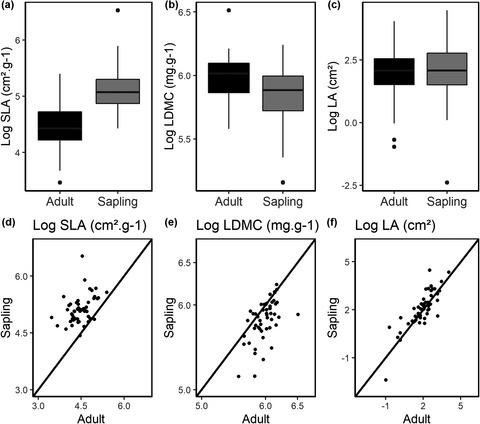当前位置:
X-MOL 学术
›
Austral Ecol.
›
论文详情
Our official English website, www.x-mol.net, welcomes your
feedback! (Note: you will need to create a separate account there.)
Plant functional traits explain species abundance patterns and strategies shifts among saplings and adult trees in Araucaria forests
Austral Ecology ( IF 1.6 ) Pub Date : 2021-05-07 , DOI: 10.1111/aec.13044 Joice Klipel 1 , Rodrigo Scarton Bergamin 1, 2 , Guilherme Dubal Dos Santos Seger 3 , Marcos Bergmann Carlucci 4 , Sandra Cristina Müller 1
Austral Ecology ( IF 1.6 ) Pub Date : 2021-05-07 , DOI: 10.1111/aec.13044 Joice Klipel 1 , Rodrigo Scarton Bergamin 1, 2 , Guilherme Dubal Dos Santos Seger 3 , Marcos Bergmann Carlucci 4 , Sandra Cristina Müller 1
Affiliation

|
Species-rich communities are composed of several locally rare and a few abundant species. A trait-based approach can derive general explanations for such species abundance distribution. However, for tree species in forests, the intraspecific variation of traits associated with the ontogeny and understory/canopy conditions must be considered. Here, we quantified intraspecific variation of leaf traits across saplings and adults in trees and tested if leaf and/or regenerative traits mediate the species abundance distribution of saplings and adults, and if saplings abundance also determines the abundance of adults in tree communities of Araucaria forests in Southern Brazil. We found intraspecific variation for specific leaf area (SLA) and leaf dry matter content (LDMC), but not for leaf area (LA). Adults have higher LDMC and lower SLA than saplings, suggesting a shift in investment strategies. Species abundant in saplings were associated with larger LA, whereas abundant species in the adults had lower SLA and LA and a larger number of seeds per fruit. The abundance of saplings also contributed to explaining the abundance of species as adults. Saplings experience low light availability in the understory, larger leaves are essential to maximising light capture. On the other hand, adult trees face high irradiation, windy and frost exposure conditions; species with lower SLA reach higher abundance. Regenerative traits were only relevant for the model of adults. Species abundance distribution in forests is related to functional traits, but the relationship is distinct for saplings and adults as leaf traits vary according to the ontogenetic stage and/or the environmental conditions imposed to individuals. In addition, we suggest the assembly of trees in the upper forest stratum is not only mediated by abiotic and biotic filters that favour some leaf and regenerative attributes, but also by lasting effects of variables that filtered out individuals in former development stages.
中文翻译:

植物功能性状解释了南洋杉林中树苗和成年树之间的物种丰度模式和策略变化
物种丰富的群落由几个当地稀有和一些丰富的物种组成。基于特征的方法可以得出对这种物种丰度分布的一般解释。然而,对于森林中的树种,必须考虑与个体发育和林下/冠层条件相关的性状的种内变异。在这里,我们量化了树木中幼苗和成虫的叶片性状的种内变异,并测试了叶片和/或再生性状是否介导了幼树和成虫的物种丰度分布,以及幼树丰度是否也决定了南洋杉林树群落中成虫的丰度在巴西南部。我们发现特定叶面积 (SLA) 和叶干物质含量 (LDMC) 的种内变异,但没有发现叶面积 (LA) 的种内变异。与树苗相比,成虫具有更高的 LDMC 和更低的 SLA,暗示投资策略的转变。幼树中丰富的物种与较大的 LA 相关,而成虫中丰富的物种具有较低的 SLA 和 LA 以及每个果实的种子数量较多。树苗的丰富性也有助于解释成年后物种的丰富性。树苗在林下的光照不足,较大的叶子对于最大限度地捕捉光线至关重要。另一方面,成年树面临高辐射、多风和霜冻暴露条件;SLA 较低的物种达到较高的丰度。再生性状仅与成人模型相关。森林中的物种丰度分布与功能性状有关,但这种关系对于树苗和成虫来说是不同的,因为叶子特征根据个体发育阶段和/或强加给个体的环境条件而变化。此外,我们认为上层森林中树木的组装不仅是由有利于某些叶子和再生属性的非生物和生物过滤器介导的,而且还由过滤掉前发展阶段个体的变量的持久影响介导。
更新日期:2021-05-07
中文翻译:

植物功能性状解释了南洋杉林中树苗和成年树之间的物种丰度模式和策略变化
物种丰富的群落由几个当地稀有和一些丰富的物种组成。基于特征的方法可以得出对这种物种丰度分布的一般解释。然而,对于森林中的树种,必须考虑与个体发育和林下/冠层条件相关的性状的种内变异。在这里,我们量化了树木中幼苗和成虫的叶片性状的种内变异,并测试了叶片和/或再生性状是否介导了幼树和成虫的物种丰度分布,以及幼树丰度是否也决定了南洋杉林树群落中成虫的丰度在巴西南部。我们发现特定叶面积 (SLA) 和叶干物质含量 (LDMC) 的种内变异,但没有发现叶面积 (LA) 的种内变异。与树苗相比,成虫具有更高的 LDMC 和更低的 SLA,暗示投资策略的转变。幼树中丰富的物种与较大的 LA 相关,而成虫中丰富的物种具有较低的 SLA 和 LA 以及每个果实的种子数量较多。树苗的丰富性也有助于解释成年后物种的丰富性。树苗在林下的光照不足,较大的叶子对于最大限度地捕捉光线至关重要。另一方面,成年树面临高辐射、多风和霜冻暴露条件;SLA 较低的物种达到较高的丰度。再生性状仅与成人模型相关。森林中的物种丰度分布与功能性状有关,但这种关系对于树苗和成虫来说是不同的,因为叶子特征根据个体发育阶段和/或强加给个体的环境条件而变化。此外,我们认为上层森林中树木的组装不仅是由有利于某些叶子和再生属性的非生物和生物过滤器介导的,而且还由过滤掉前发展阶段个体的变量的持久影响介导。











































 京公网安备 11010802027423号
京公网安备 11010802027423号